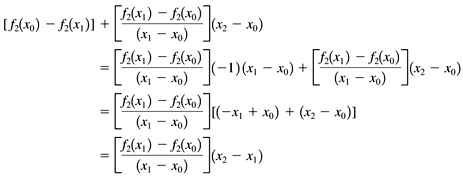6.2 Polynomial Interpolation Functions
6.2 Polynomial Interpolation Functions If we are given two data points in the xy plane, there is one, and only one, polynomial interpolation function f 1 ( x ) of degree 1 that will pass through both points a line function. As shown in Figure 6-2, let the two points be ( x , f 1 ( x )) and ( x 1 , f 1 ( x 1 )). Then, using similar triangles , we have Figure 6-2. A line in the xy plane. and so Notice that we have derived the Newton form of the polynomial where the coefficients b = f 1 ( x ) and b 1 = the quantity in the square brackets. The quantity in the square brackets is called a divided difference, and it happens to be the slope of the line. As we'll soon see, divided differences play a major computational role in determining polynomial interpolation functions. If there are three points in the xy plane, then there is a polynomial interpolation function f 2 ( x ) of degree 2 that will pass through all three points. This is a quadratic function, which describes a parabola. Although we won't prove it here, this parabola is unique for any three given points. The Newton form of the parabola is where the centers x and x 1 are the x coordinates of two of our three given points. The coefficients b i are constant their values are the same for any value of x. So to compute b , first set x to the value x to get rid of the terms containing b 1 and b 2 , and we see that Now set x to the value x 1 to get rid of the term containing b 2 and substitute in the value we just computed for b : and so Finally, set x to the center value x 2 (the x coordinate of the third point) and substitute in the values for b and b 1 : Subtract f 2 ( x 1 ) from both sides: But since we have Divide both sides by ( x 2 - x 1 ), and we get and finally Notice that the values of b and b 1 are similar to the corresponding values we had computed for the first degree polynomial. The definition of b 2 is recursive it's a divided difference that is composed of two divided differences. In general, if we are given n +1 points, then there exists a unique polynomial function f n ( x ) of degree n that passes through all the points. |
| |
| Top |
EAN: 2147483647
Pages: 141




